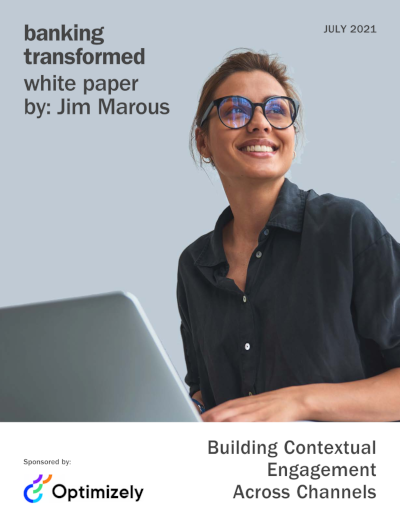Building Contextual Engagement Across Channels
White Paper
Jim Marous
July 2021
: DBR 281
24 pages, 12 tables/charts
Download Printable Version of this page
The ability to personalize communication and experiences across the customer journey is not a new phenomenon, but the ability to deliver personalization at scale has been made much easier with the availability of greater amounts of data, new analytic capabilities, and new technologies that can respond to opportunities in real-time. The pandemic raised expectations of consumers to have individual experiences as opposed to an experience which is delivered to the masses. With the flight to digital channels, people were exposed to personalization in everything they encountered, including marketing messages, products, digital content, and even cars, making expectations even higher.
Consumers are attracted to personalized experiences because they make them feel special and unique. Personalization gives the impression that people matter on an individual level to the banks and credit unions that serve them. This is despite the fact that most personalization is an automated process, made possible by the collection of massive data sets and increasingly sophisticated analytics.
The University of Texas did a study, Consumer Control and Customization in Online Environments that found that two factors drive consumer’s desire for personalized experiences: control and information overload. While marketing messages are coming at consumers from all directions, technology has put consumers in the driver’s seat in terms of what they see, experience and engage with. As a result, consumers are not only controlling trends through behavior and social sharing, but also the strategies that brands use to reach these same consumers.
According to Psychology Today, when consumers feel a sense of internal control, they believe that they are in control of all aspects of life, which makes them feel happier, more successful and even healthier. Even though it is an illusion, it is important to the consumer and it is effective.
The second reason why consumers prefer personalized experiences, according to the University of Texas study, is because it helps reduce information overload. Actually, personalization makes consumers think they are receiving less of an overload.
Despite wanting simplicity and personalization, people also want choices, and the ability to determine what is right for them. So, while financial marketers want to find ways to reach consumers in a highly customized manner, they want to provide relevant choices that both empower and enlighten. If done well, choice can actually enable control.
Done well, personalization benefits both the consumer and the financial institution. And the banks and credit unions that best understand the psychology of personalization will do the best connecting with consumers.
Consumers want the companies they work with to know them, understand them and reward them as an individual. For a bank or credit union to eliminate noise and provide financial solutions that apply to a specific need or are driven by a real-time behavior provides value to the consumer that builds trust and loyalty.
When a financial institution gets it right, contextual engagement provides the impression that all customers have their own 24/7 personal assistant who can be trusted to help them make the best possible decisions. This is what they are receiving from the big tech firms and what will be the primary differentiator in the future.
We would like to thank Optimizely for sponsoring this research on the state of contextual engagement and personalization for financial institutions. The insights contained in this white paper provide the foundation for building better relationships and revenues across the entire customer journey.
Building Contextual Engagement Across Channels
Advanced Analytics, AI, Analytics, Artificial Intelligence, Bank, Banking, Big Data, Credit Union, CRM, Customer Experience, Customer Journey, Data, Digital Banking, Digital Lending, Digital Marketing, Digital Transformation, Engagement, Fintech, Innovation, Loyalty,
Machine Learning, Marketing, Mobile Banking, Payments, Personalization, Technology, Trends, Website

